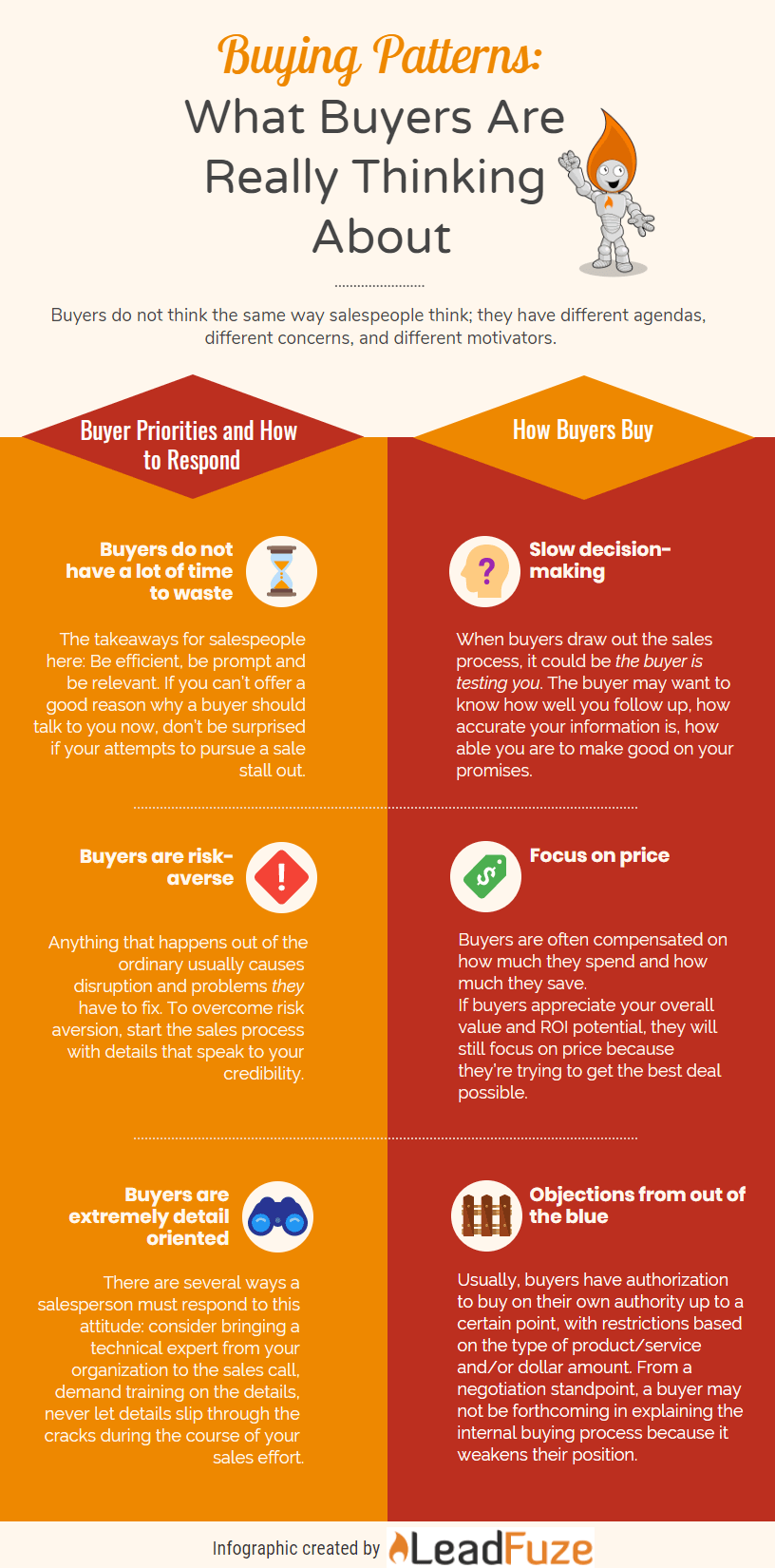Understand the Customer’s Buying Patterns
Salespeople sometimes find the buying patterns of buyers to be quite baffling.
Why all these questions? Why not make a decision? Everything sounded so positive … what went wrong?
For many years, I’ve spent a good part of my career in purchasing and in sales, I’ve learned that buyers do not think the same way salespeople think.
They have different agendas, different concerns, and different motivators. And, just as good salespeople have a system for selling, good buyers have buying patterns.
Let’s take a look at the buyer mentality — a better understanding of it will help you conduct your sales calls more comfortably and effectively this 2021 and in the years ahead.
Behind the Buyer’s Desk
Buyers tend to be overworked. A lot of their day-to-day activity is spent on detailed work, putting out fires, and cleaning up other people’s messes.
A typical day involves activities such as:
- For accounts payable, reconciling a price difference between a quote and an invoice on a particular line item
- And the operations manager, expediting delivery of a manufacturing item with the vendor and the vendor’s freight company, to prevent a production line from shutting down
- For the director of purchasing, updating a report on inventory turns for 500 post-production inventory items
- Finally, the warehouse manager, working with a vendor to change the number of boxes on a pallet to improve storage efficiency
Multiply this type of work by about 10, and you have a typical day in the life of a buyer. What sorts of things can we conclude from this?

Learn How to Respond to Buyer Priorities
There are three important conclusions we can draw about buying patterns that I’d like to bring to your attention.
Please keep in mind that throughout this article, we’re dealing in general terms; not all buyers are alike, just as not all salespeople are alike.
1 Don’t Waste Their Time
When they have other people breathing down their neck (often higher-ups) for answers, they have little patience for unreturned phone calls, confusing emails, and dealing with peripheral issues.
The takeaways for salespeople here: Be efficient, be prompt and be relevant. Share on XIf you can’t offer a good reason why a buyer should talk to you now, don’t be surprised if your attempts to pursue a sale stall out.

Furthermore, don’t take it personally if a buyer puts you off. It isn’t personal. The buyer is probably too busy to focus on what you’re trying to propose.
A good solution to the problem is suggesting a time to meet or talk during off-hours — before work, at lunch, after work.
The buyer will then be able to focus and may appreciate a chance to relax and deal with a big-picture issue.
2 Understand that Buyers are Risk-averse
I think this is partly or largely due to on-the-job conditioning — anything that happens out of the ordinary usually causes disruption and problems they have to fix.
Because of this attitude, any new salesperson who enters the scene will be viewed not only as a distraction, but also as a potential headache.
From the buyer’s point of view, the distraction and headache are very real, but whatever value proposition the seller is making seems abstract and distant.
In response to this, salespeople must combine persistence with patience.
It’s going to take buyers some time to get comfortable with you and whatever it is you’re selling.
Push too hard and you’ll push them away. Of course, if you don’t push at all, you’ll never sell anything.
To overcome risk aversion, start the sales process with details that speak to your credibility — how your product/service helped a company in the same industry, how many years you’ve spent selling to the same industry, awards and recognition your company has received, etc.
3 Be Detail-oriented Like Your Buyers
This is really important for sellers to appreciate because salespeople tend not to be detail-oriented.
What buyers infer from a seller’s sweeping statements is this: The seller cannot be relied upon to take care of the details, or the seller doesn’t understand the details.
And the buyer thinks, “If the seller doesn’t know the details or care about the details, why am I talking to this person?”
There are several ways a salesperson must respond to this attitude.
First, consider bringing a technical expert from your organization to the sales call.
The buyer may be far more eager to talk to someone he or she perceives as a detail person.
Second, demand training on the details if you haven’t received it.
Third, never, ever let details slip through the cracks during the course of your sales effort.
The smallest oversight may seem like a huge issue from the buyer’s point of view.
How do Buyers Buy?
Once you have the sales ball rolling, you may encounter situations that are easily misinterpreted.
While buying patterns sometimes seems perplexing or frustrating to salespeople, there is often a good reason behind it.
Let’s consider a few common issues.
1 Slow decision-making
When buyers draw out the sales process, when they ask for a lot of information that seems like overkill, it could be the buyer is testing you.
The buyer may want to know how well you follow up, how accurate your information is, how able you are to make good on your promises.
Whether you realize it or not, you are in the midst of an audition, and instead of getting a role in a movie, you’re auditioning for a role in the buyer’s organization as a vendor.
2 Focused on price
Sellers often complain that buyers are totally focused on price, when they should be concerned about overall value and ROI.
Two very important things to keep in mind here.
First, buyers are often compensated on how much they spend and how much they save; like all people, buyers do what they’re paid to do.
Second, if buyers appreciate your overall value and ROI potential (and they probably do), they will still focus on price because they’re trying to get the best deal possible. If buyers admit that your product or service is worth the asking price, it works against them in the negotiation.
In addition, you can safely assume buyers will not tell the truth if you ask them what they are currently paying for a product or service.
They don’t do this because they are dishonest or dislike you — it’s Negotiating 101. Thus, asking a buyer what they are currently paying is a bad question. Instead, ask:
- If my price for “X” is “Y,” would you place an order?
- At what price would you order my product/service?
These questions are actually more comfortable for a buyer to answer — although you can assume the answer is on the low side of what he or she would actually be willing to pay.
3 Objections from out of the blue
A sales effort can be sailing along, and suddenly the buyer confronts you with an unexpected objection or outright “no.”
This is quite discouraging and often happens because the seller does not realize how decisions are made within the buyer’s organization.
Usually, buyers have the authorization to buy on their own authority up to a certain point, with restrictions based on the type of product/service and/or dollar amount.
In larger organizations, adding a new vendor may require multiple sign-offs regardless of product and dollar amount.
From a negotiation standpoint, a buyer may not be forthcoming in explaining the internal buying process because it weakens their position.
Therefore, salespeople must be sure to understand these buying patterns early in the sales process. Good questions that get at this include:
- Can you walk me through the process of adding a vendor at your company?
- Is there anyone else involved with making a decision to buy this product/service?
- Anyone else here I should talk to about this product/service?
- Is there anything production/quality control/warehousing needs to know about this product or service?
Different types of Buyer Behavior
There are four primary forms of buyer behavior:
1 Variety-Seeking
With this behavior, the buyer chooses a different service not out of dissatisfaction with the prior one, but out of a need for variety.
It’s just like when you’re trying to find the exact perfume smell that fits you.
2 Dissonance-reducing
The buyer is deeply engaged in the purchasing process yet struggles to distinguish different brands.
Dissonance might develop when a buyer fears they will regret their purchase.
Consider purchasing a mower. You’ll select one based on cost and availability, but once you’ve made your purchase, you’ll seek validation that you made the correct option.
3 Complex Behavior
This behavior is when consumers purchase high-priced, rarely purchased goods.
They play a significant role in the purchasing process and in the research prior to making a high-value buy.
Consider purchasing a home or a car; these are examples of complex purchasing behaviors.
4 Habitual Buying
Habitual buys are defined by the buyer’s lack of information about the product or business category.
Consider the following scenario: you go to the store to purchase your favorite type of cheese.
You are demonstrating a pattern of behavior, not powerful brand devotion.
Build Good Relationships with Buyers
Although buyers like to focus on price during a negotiation, they understand the importance of a strong business relationship.
Normally, buyers are very protective of the vendor relationships they have in place.
If a buyer has a vendor that performs well, and especially if this vendor has people enjoyable to work with, the buyer will be very reluctant to jeopardize the relationship — and also very reluctant to tell you so.
Thus, in the same way, buyers want the negotiation to focus on price, the seller wants to bring relationship issues to the forefront, but very carefully. Questions that help ferret out relationship issues:
- How would you rate your current vendor on a scale of 1-10? Why that number?
- Where does your current vendor really perform well? Where do you think performance could be better?
- What do you like most about your current vendor?
- What can I tell you about me or my organization that will give you confidence that we can do the job for you?
The answers to these questions should give you a feel for whether you are up against a vendor with a weak or strong relationship with the buyer.
If the relationship is weak, you may be much closer to a sale than the buyer is leading you to believe. If the relationship is strong, don’t give up.
A persistent yet patient approach may win over a buyer in time. Share on XImportance of Understanding Customer Behaviour
76 percent of consumers expect businesses to understand their requirements and expectations, according to a Salesforce survey.
This means that if you don’t comprehend what a consumer wants before they can communicate it to you, they’re likely to go elsewhere.
1 Draw Buyers Closer to the Company
A thorough and systematic understanding of buying patterns enables a business to grasp their consumers’ demands and standards.
This in turn enables them to build products and package services that are most useful to clients, thereby bringing them closer to the brand.
Analyzing customer buyers’ behavior enables a firm to establish a price range for certain client categories, design the most successful promos and reward programs, and treat consumers in a way that encourages customer loyalty and referrals.
2 Shape Buyer’s Opinion
The additional benefit of understanding customer’s buying patterns is that it enables a customer to alter their behavior to their advantage.
It enables a business to shape and sway customer opinion in its favor, so attaining its objectives of increased sales, profits, and long-term success.
3 Properly Time Your Advertising Techniques
Observing client behavior can assist a business in determining the optimal timing for promotions, advertising, and other marketing campaigns.
For instance, if a business notices that a certain consumer is more likely to purchase at the end of the season, they might send that client advertising messages telling them about end-of-season deals and other incentives.
Learn more about the importance by reading Emily Newman’s take.
Conclusion
Success in business is not solely determined by delivering exceptional items or those that appear to be the latest fad. Without an awareness of buying patterns, a business’s endeavors will be in vain and all of their achievements will be useless. We hope this blog is helpful for you to step up in analyzing your customers’ buying patterns.
Want to help contribute to future articles? Have data-backed and tactical advice to share? I’d love to hear from you!
We have over 60,000 monthly readers that would love to see it! Contact us and let's discuss your ideas!

